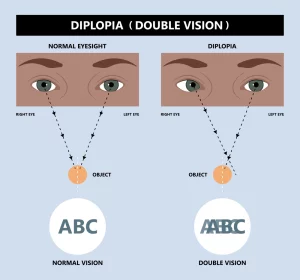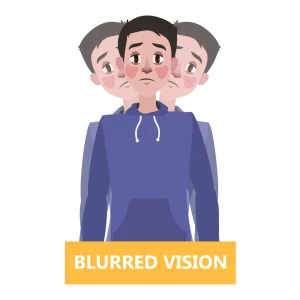What is double vision?
 When you stare at an object, you may have double vision, also known as diplopia, which causes you to see two separate images of the same thing. The image that is the faintest is referred to as a “ghost image.” Diplopia is sometimes misunderstood to be blurry eyesight. People do not take this condition very seriously as they consider it a temporary issue. No doubt it is a temporary issue but can cause serious health problems if you do not take the proper treatment. It may be in one eye or both eyes. It can be more serious if you find it in both eyes rather than in one eye.
When you stare at an object, you may have double vision, also known as diplopia, which causes you to see two separate images of the same thing. The image that is the faintest is referred to as a “ghost image.” Diplopia is sometimes misunderstood to be blurry eyesight. People do not take this condition very seriously as they consider it a temporary issue. No doubt it is a temporary issue but can cause serious health problems if you do not take the proper treatment. It may be in one eye or both eyes. It can be more serious if you find it in both eyes rather than in one eye.
Role of ICD 10 in double vision:
ICD 10 code stands for International Classification of Diseases and the 10th edition of codes consists of alphanumeric codes used by healthcare providers to identify the diagnoses and reasons for visits to patients. These codes help streamline communication among healthcare professionals and insurance providers, ensuring accurate billing and effective patient care. ICD codes are used by healthcare providers, hospitals, and insurance companies all around the world to categorize injuries, illnesses, and diseases.The importance of ICD 10 codes:
The significance of ICD 10 codes: ICD 10 codes are important because they give the provider complete and accurate details. Accurate documentation results in improved patient care. Additionally, it helps in lowering billing mistakes and misunderstandings that lower the number of denied claims. ICD 10 provides a comprehensive picture of the patient’s state, which can be useful for future usage.Types of double vision:
There are two types of double vision:Monocular double vision:
Monocular double vision or Monocular Diplopia is a condition in which you see a double object from a single eye even if you see it in different directions this double image is not removed.Binocular double vision:
Binocular double vision or Binocular Diplopia is a condition in which you see the same object twice from both of your eyes. This is also considered true Diplopia and more dangerous than Monocular double vision.Causes of Double Vision
 Double vision can stem from various causes, and understanding the root of the problem is crucial for accurate diagnosis and treatment.
Double vision can stem from various causes, and understanding the root of the problem is crucial for accurate diagnosis and treatment.
Muscular Causes
Muscular issues, such as strabismus or eye muscle weakness, can result in double vision. These conditions affect the alignment and coordination of the eye muscles, leading to misaligned vision.Neurological Causes
Neurological factors, such as nerve damage or brain disorders, can also cause double vision. These conditions disrupt the communication between the brain and the eyes, leading to visual disturbances.What are the Symptoms of Double Vision?
- eyesight weakness
- When moving the eye, it hurts
- Headache
- Crossed eyes, often known as “wandering eyes”
- Nausea
- falling eyelids
ICD-10 Structure for double vision
ICD-10 Structure is broken out into chapters, each of which discusses a different category of disorders. Double Vision falls under Chapter VII, titled “Diseases of the Eye and Adnexa.”Cracking the Code for Double Vision
Identifying the ICD-10 code for double vision will now be the focus of this discussion. H52.2, which belongs to subcategory H52, is the main code for this disease. Remember that depending on the underlying reason, the ICD-10 offers additional subcodes for double vision. A more detailed explanation of the condition is provided by these subcodes.Common Subcodes for Double Vision
- H52.21 – Vertical Diplopia: Vertical double vision occurs when the images seen by one eye are displaced vertically relative to each other.
- H52.22 – Other Diplopia: This code is used when the double vision does not fit into the categories of horizontal or vertical diplopia.
- H52.23 – Alternating Exotropia: Alternating exotropia refers to a condition where each eye takes turns drifting outward, leading to double vision.
When to Use Additional Codes
Healthcare professionals utilize ICD-10 codes to identify the underlying cause of double vision in patients. They may then create a treatment plan that works and make sure that insurance claims and billing are handled correctly.Treatment and Management of Double Vision
The cause of your double vision will determine how to treat it. It could entail dealing with neurological or muscular problems, dispensing corrective glasses, or advising eye exercises. The key to reducing double vision symptoms is early diagnosis and effective management.ICD-10 Documentation Tips
Accurate documentation is essential when using ICD-10 codes. Healthcare professionals should ensure that they record the specific code that best represents the patient’s condition. Additionally, they should include any relevant details and supporting documentation to justify the chosen code.Final thoughts:
Understanding the ICD-10 Classification for Double Vision is paramount for healthcare professionals, ensuring accurate diagnosis, treatment, and communication within the medical community. By cracking the code and utilizing the appropriate subcodes, medical practitioners can provide the best possible care for patients experiencing Double Vision.Why choose Zee Medical Billing?
Experience hassle-free billing solutions with Zee Medical Billing, your trusted partner for Double Vision medical billing services. Our expert team ensures accurate and timely billing, so you can focus on patient care while maximizing revenue. Choose the best medical billing company, Zee Medical Billing and simplify your billing process today!Frequently Asked Questions
Yes, Double Vision can be a symptom of various underlying health issues, including neurological disorders and eye conditions. It’s crucial to consult a healthcare professional if you experience persistent Double Vision.
The ICD-10 code for Double Vision is determined based on the specific nature and cause of the Double Vision. Healthcare providers assess the patient’s symptoms and use the appropriate subcode to accurately reflect the condition.
Yes, the treatment for Double Vision depends on its underlying cause. Different subcodes may require distinct treatment strategies, ranging from eye exercises and corrective lenses to surgical interventions.
Not necessarily. Double Vision can be temporary and benign, such as when tired eyes cause a brief episode. However, it can also indicate serious health problems. If you experience Double Vision, it’s crucial to seek medical advice for a proper evaluation.
Healthcare providers must thoroughly assess the patient’s condition, conduct necessary tests, and determine the underlying cause of Double Vision. Accurate documentation and coding are essential to ensure proper treatment and insurance coverage.





